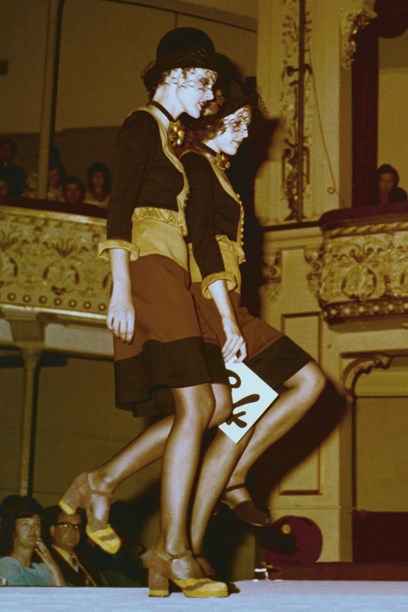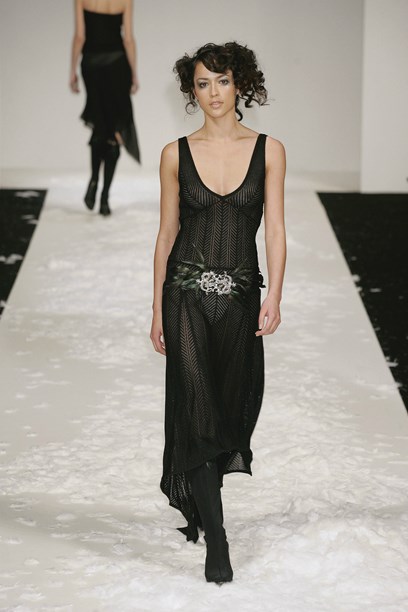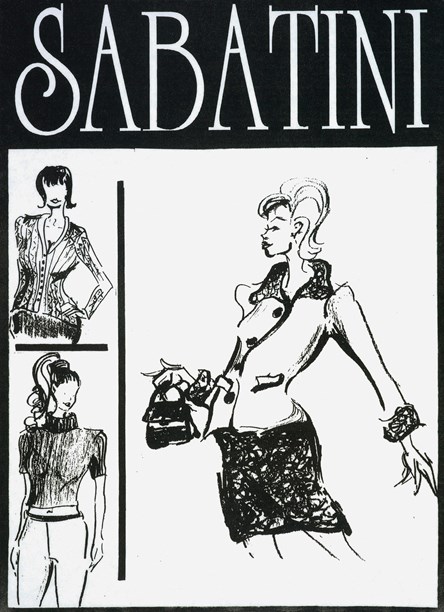Stories
Sabatini
1990-

Sophisticated, sexy, flirty and fabulous, knitwear designer label Sabatini may have been born in the 1990s but its silhouette, style and attitude harks back to the swinging 60s.
It’s a little known fact but Tony Milich of designer knitwear label Sabatini has the distinction of being the first New Zealander to study fashion design at the Royal College of Art, London in 1969. He also spent time living in London in the mid-1960s soaking up the vibrant scene.
Back then, the Royal College of Art’s alumni Zandra Rhodes and Ossie (Raymond) Clark were making international fashion headlines and when Tony returned to Auckland, New Zealand in 1971 he made headlines of his own.
His debut collection fashion show at Her Majesty’s Theatre was attended by 1200 people, including the Mayor. It was akin to an 'Austin Powers' moment in terms of the excitement Tony generated with his designs, which he launched under his own Anthony Milich Collection label. The garments reflected the mood of the latest trends in London, although in Tony’s case (unlike the fictional character in the 1997 film) the sensation his clothing created was very real.

Tony Milich started his career designing under the Anthony Milich label. Image © Tony Milich.
Tony took his fashion show on tour in New Zealand, even modelling in the shows himself. He eventually married another model, Sheryl Gwilliam from Auckland.

Tony Milich's debut fashion collection, 1971. Image © Tony Milich.
Tony was a regular entrant in the Benson & Hedges Fashion Design Awards, earning a highly commended award in the Men’s Fashion category in 1973, and winning the Leisure Lifestyle Award in 1987.
Fast forward to the present day and Tony helms Sonny Elegant Knitwear, the company founded by his Croatian parents Zarko and Sonia Milich in 1953. Based in Mt Roskill, Sonny Elegant Knitwear is home to labels Sabatini, Sabatini White, Aliza, Sabatini Man and Sabatini Home. They are manufactured on knitting machines that the Milich family imported in the 1960s.
It all started with fringed wool shawls spangled with lurex thread made by Zarko and Sonia in their home on a knitting machine. War refugees, Zarko was a mining engineer in Croatia and Sonia didn’t know how to knit but she learned everything she needed to know. The shawls were a hit and the family firm grew, eventually expanding into apparel and opening a small factory in Balmoral before opening in Mt Roskill.
Tony was born on 11 July 1945 in Zagreb, Croatia. He was eight years old when the family came to New Zealand in 1952. His first impression of Auckland was the view of the brand new Parnell pools from the railway carriage window "which looked summery and fabulous".
When Tony joined the family business the decision was made to invest in English-made knitting machinery. He travelled to England where he spent six months in Leicester at Wildt Mellor Bromley Ltd (where two of the three machines they purchased were made), and three months in Loughborough where the third machine was manufactured. He returned to New Zealand with a thorough understanding of what they were capable of. "I wasn’t a mechanic, I was more interested in what they could do," says Tony. "Then I thought, if I’m going to get involved in serious design I need to get training."
So he returned to London where he completed a two-year certificate at the Royal College of Art specialising in knitwear. "When I came back to New Zealand, that’s when I felt a fully fledged designer," Tony recalls.
Tony runs the business in partnership with his sister, Margie Milich, Sabatini’s Sydney-based creative director. Margie joined the business in 1990 and they introduced the Sabatini label when they felt the Sonny brand was in need of a makeover. It has gone on to become an international success and red carpet go-to for stylists and celebrities, particularly in Australia.
The training and investment in the knitting machines, upon which Sabatini creates its original fabrics to this day, are one of the reasons for Sabatini’s success. "Our design philosophy and the fact that we choose our own colours and have our own fabrics makes Sabatini unique. That gives us a point of difference," he says.
He also credits their survival by being willing to change. In 2015 the company retired its Sonny and Sonny in Love labels, and launched Sabatini Home in response to the growing market for designer homewares. "If you want to survive and keep going you have to keep changing with the times," he says. It’s this attitude that has kept them competitive
The turning point for Sabatini label was what he describes as "showtime", when the label showed at the inaugural New Zealand Fashion Week in 2001. Sabatini White’s collection of long-haired hippy-esque knitted coats with shag-pile collars teamed with teensy, tight knitted shorts, wowed the fashion press, including British-based New Zealand fashion editor of London’s Daily Telegraph Hilary Alexander. She dashed backstage immediately following the show and later emerged with a pair of Ugg boots in her grasp. She wore them that week too!
Two years later Sabatini White’s provocative and sexy 'Seduction' collection (2004) presentation at New Zealand Fashion Week, held in the foyer of Auckland War Memorial Museum, earned them acclaim locally as well as a significant order with American department store Henri Bendel making them the first New Zealand brand to sign such a deal with the New York store. "The overall impression was of clothing designed for screen sirens who had just rolled out of bed to go straight to the nightclub," wrote author Angela Lassig in New Zealand Fashion Design.

Sabatini White Winter 2005 on the runway at New Zealand Fashion Week, 2004. Image © Sabatini.
Sophisticated and chic, Sabatini sits in the upper end of the middle market making it an affordable luxury purchase. Their use of wool, and more recently leather, adds to its appeal, and the fact that there isn’t an over supply.
In the years following Sabatini opted not to show at New Zealand Fashion Week so that it could focus its attention on Europe (though it was part of the New Zealand Woolmark 50th Anniversary show in 2015). The decision followed the label’s success at Tranoi Montaigne in 2005 when Sabatini was invited by New Zealand Trade & Enterprise along with labels Zambesi, NOM*d, Sharon Ng and WORLD to the trade fair in Paris. One order, for nearly eight hundred dresses, placed by New York department store Searle, was only able to be half filled due to Sonny’s limited production capacity. The label was a particular hit with Italian buyers who affectionately referred to Sabatini as "baby Missoni". Soon Sabatini had accounts all over Italy.

Sabatini ad. Image © Sabatini.
Part of the appeal in Italy was the label’s name, thinks Tony, who named the label after the family’s favourite restaurant, Sabatini, in Milan. The family lived in Italy after fleeing Croatia. Italian was his first language and he remembers it fondly. "The restaurant is still there. It’s always busy. We still go from time to time," Tony says. "I thought the name sounded great and it’s been a name that has really caught on."
The global recession in 2008 spelled the end of exporting to Italy. "We had to pull out quickly because everyone was going broke," he says.
One market that has remained constant is Australia, to which Sonny exports more than three quarters of its product. In Australia, Sabatini is revered in the designer clothing market. It is positioned in leading department store David Jones as one of the few designer brands to be featured in the department store’s seasonal high profile fashion shows and catalogues, which have an audience of 900,000 women. For Sabatini, the alliance with David Jones is as important, if not more so, than any fashion week.
The fact that Sabatini garments are made of wool and natural fibres is another big tick for David Jones. In 2015 Sabatini celebrated its 50th anniversary as a Woolmark brand. The Woolmark certificate hangs in Tony’s office, where the earliest surviving garment created by Sonny also hangs in a glass frame. To look at it, one can clearly see the beginning of what was to become the label’s flirty signature, with fringing decorating the neckline of an otherwise sophisticated fine knit black top. Over the years fringing has appeared on shawls, coats and ponchos as well as hems of Sabatini’s body hugging knit dresses. Lurex has been a recurring theme too.
Yep, Sabatini has sass, and the fact that it continues to produce its original fine knits on machines purchased back in the 1960s is just 'fantastic baby'.
Text by Carolyn Enting. Banner image © Tony and Margie Milich.
Last published November 2015.